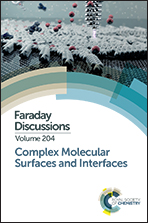Exploring catalyst passivation with NMR relaxation†
Abstract
NMR relaxation has recently emerged as a novel and non-invasive tool for probing the surface dynamics of adsorbate molecules within liquid-saturated mesoporous catalysts. The elucidation of such dynamics is of particular relevance to the study and development of solvated green catalytic processes, such as the production of chemicals and fuels from bio-resources. In this paper we develop and implement a protocol using high field 1H NMR spin–lattice relaxation as a probe of the reorientational dynamics of liquids imbibed within mesoporous oxide materials. The observed relaxation of liquids within mesoporous materials is highly sensitive to the adsorbed surface layer, giving insight into tumbling behaviour of spin-bearing chemical environments at the pore surface. As a prototypical example of relevance to liquid-phase catalytic systems, we examine the mobility of liquid methanol within a range of common catalyst supports. In particular, through the calculation and comparison of a suitable interaction parameter, we assess and quantify changes to these surface dynamics upon replacing surface hydroxyl groups with hydrophobic alkyl chains. Our results indicate that the molecular tumbling of adsorbed methanol is enhanced upon surface passivation due to the suppression of surface-adsorbate hydrogen bonding interactions, and tends towards that of the unrestricted bulk liquid. A complex analysis in which we account for the influence of changing pore structure and surface chemistry upon passivation is discussed. The results presented highlight the use of NMR spin–lattice relaxation measurements as a non-invasive probe of molecular dynamics at surfaces of interest to liquid-phase heterogeneous catalysis.
- This article is part of the themed collection: Complex Molecular Surfaces and Interfaces


 Please wait while we load your content...
Please wait while we load your content...